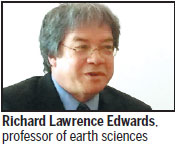After World War II, father met mother at Yale University where she worked as a professor
"My story is an integral part of my family history," said Richard Lawrence Edwards, professor of earth sciences at the University of Minnesota, who became a member of the Chinese Academy of Sciences last year.
"Seventy-three years ago, my father was driving a charcoal-powered truck along the southwestern border of China, to transport medical supplies for the Allied Army during World War II," the 53-year-old said.
"Yesterday, I was sitting inside the Great Hall of the People in Beijing, being received by the country's leadership."
For the past seven years, Edwards has been working closely with "a whole host of really stunning Chinese collaborators", to use the scientist's own words, developing a deeper understanding of climate change.
"My main contribution, technologically, is to get the precise age for each layer of cave deposits, through uranium-thorium dating methods," he said.

"Applying this method to the study of climate history has enable us to travel across the time tunnel back to 600,000 years ago."
While the scientist has helped to "train people and set up laboratories", the collaboration has also given him access to Chinese caves that he might otherwise not have been able to see.
Edwards first visited China as a tourist in 1980, coming with his parents "for whom every visit was laden with memories", he said.
His mother, Vee Tsung Ling, was born in 1918 in Xiamen, Fujian province and went to study in the United States at the age of 18.
"She was the only Asian in her class and was very homesick," said Edwards.
"In fact, I believe that she missed China for a good portion of her life."
At the end of World War II, Ling became a Chinese language professor at Yale, where she met Edwards' father, who was also called Richard.
"They married in 1947. And that was after my father came back from the Chinese battlefield, where he stayed for about two years between 1943 and 1945," the son said.
The elder Edwards had served in the US Army in Africa and Italy, and offered to be transferred to the China-Burma-Indian Theater toward the end of the war.
"There, he joined a volunteer group called the France Ambulance Unit, transported supplies, and fell in love with China," the son said.
After getting married, the couple came back to China in 1949 and had their first child - Edwards' eldest sister - but had to leave after the outbreak of the Korean War in 1950.
Upon returning to his mother's homeland, Edwards, through his work, got a unique insight into Chinese history and culture.
"My research into the cave records allows me to learn about how monsoon rainfall changes and why it changes over time. The records suggest that dry conditions gravely affected agriculture and contributed to the demise of the Tang Dynasty (AD 618-907)," said Edwards, who is also the member of the United States' National Academy of Sciences.
"It's worth noting that at around the same time as the fall of the Tang, drought in Central America hastened another dynastic change.
"Relating the records we gathered from Chinese caves with the ones of ocean sediments and ice cores, we get a worldwide pattern of climate change."
Back in 1972, Edwards's mother acted as an interpreter for the first Chinese table tennis team to visit the United States.
Three years later, she was invited back to China.
"Later this year, my eldest daughter is coming to China to teach English at a university in Shanxi, and my younger daughter is currently studying Chinese," said the scientist, whose own Chinese name, Ai Si Ben, was given to him by his parents.
"The story goes on."
